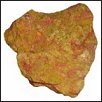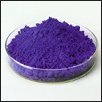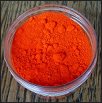Pigment Analysis of Paintings

When examining the pigments in a painting, we can determine several things:
- When was the painting not created?
- How has it been repaired?
- Is the painting an original or a forgery?
If the pigment contains organic carbon, we can date the pigment using radiocarbon dating.
Our sample collection techniques are as non-invasive as possible. Contact us to discuss our pigment analysis services in more depth.
The History of Pigment in Art
The biggest element that researchers look for in pigment analysis is the specific type of pigment. This will tell researchers and authenticators everything from what type of pigment the artist used, to whether or not a certain pigment was even in existence at the time the painting was created.
The following is a timeline of popular pigments that were used in the creation of paint throughout the years. Some from the prehistoric era are still used today!
Prehistoric/Ancient Pigments
Ochre: Often used for glazes, ochre can either be opaque or transparent. It has been used throughout history. It is made from naturally tinted clay. This is perhaps one of the most commonly found pigment families in the history of color, and it is still used today.
 |
Brown Ochre |
 |
Yellow Ochre: (limonite) |
 |
Red Ochre: (haemetite) |
 |
Madder Red: This pigment, also known as Alizarin, made its artistic debut in the early 1800s, with a synthetic version created nearly 100 years later. However, madder red has been around since 1500 B.C. |
 |
Azurite: This beautiful blue pigment was used from 2500 B.C. and was commonly known as Egyptian blue. It was used from the Renaissance through the 1700s. |
 |
Orpiment: This yellow pigment, arsenic sulfide, was only used from 3000 B.C. to the early 1900s because of its toxicity. |
 |
Ultramarine: First used in 600 A.D., ultramarine was a highly sought-after blue pigment, but it was also one of the most expensive. This pigment, created from the precious lapis lazuli stone, was coveted during the Renaissance era for its use in religious paintings. A synthetic version was created in the 1800s and became more widely used in art after that. |
 |
Vermilion: Another very expensive pigment, lovely red vermilion is created from the ground mineral cinnabar. First used around 500 A.D., vermilion is rarely used today because it is considered to be toxic. |
Antique Pigments
 |
Carmine: Though South Americans were the first to use carmine, this lovely red pigment became available to European artists in the 1600s. Created from the dried bodies of the cochineal bug, this pigment was used to make dyes, paints, and stains. However, it isn't widely used in art today. |
 |
Charcoal Black: Used from the 1300s to today, charcoal black is also referred to as "carbon black." This is created when organic materials are partially burned, or carbonized, and then turned into charcoal. Charcoal black was popular among artists for sketching on canvas because it was easily covered by oil paints. |
 |
Chalk: Made from limestone or calcium carbonate, chalk has been used in art since before the Renaissance. Today, chalk is typically used in drawing, but it can also be used in pastel form. |
 |
Malachite: Malachite is a lovely pigment made from the ground ore of copper carbonate. It was very popular during the Renaissance, but because of its toxicity, it was replaced by a synthetic version in the 1800s. |
 |
Indian Yellow: Also called euxanthin, Indian yellow was discovered in the 1400s and was not used much after the 1900s. Indian yellow was a popular pigment for oil and watercolor paints. It was made by grinding magnesium euxanthate, or cow urine. The practice of grinding cow urine was later banned because achieving the bright yellow hue meant feeding the cows only mango leaves and water. This yellow pigment can be very transparent. |
 |
Terra Verte: This greenish pigment was highly sought-after by Renaissance painters to create skin undertones. Terre verte is derived from iron silicate and clay. It is rarely used today. |
 |
Indigo: Discovered by none other than Marco Polo in the 1200s, indigo is still widely used today. Indigo is derived from the indigo plant and was popularly used as a dye or ink. It was replaced by a synthetic version in the 1800s. |
 |
Lead White: Lead white was widely used in the art world from the 1300s to the late 1800s. Lead white is the by-product of disintegrating lead in acid. Because of its toxicity, it is no longer used. It is easily spotted in an x-ray because of its lead content. |
 |
Verdigris: Verdigris was a popular pigment used from the Middle Ages through the late 1800s. Verdigris is created by placing grape skins on copper plates and allowing them to ferment, thus creating a green crust. This reaction is similar to what happens to a copper penny when it turns green. The use of verdigris was discontinued because of its toxicity. |
Contemporary Pigments
 |
Cadmium Orange: Cadmium Orange was first discovered in the early 1800s and is still used today. It is derived from cadmium metal. |
 |
Cadmium Yellow: Cadmium Yellow was first discovered in the early 1800s and is still used today. It, like cadmium orange, is derived from cadmium metal. |
 |
Cerulean Blue: Used since the 1860s, cerulean blue was a popular pigment that is typically used to paint the sky in landscapes. Cerulean blue is a pigment created by heating cobalt oxide with other metallic bases. |
 |
Cobalt Blue: Cobalt blue was a pigment first used in the early 1800s. It is derived from smalt, the isolation of the blue pigment in cobalt glass. It is still used today. |
 |
Cobalt Green: Cobalt green has been used from the early 1800s to today. It is an expensive and difficult pigment for artists to work with, so it is rare to find cobalt green used in a painting. |
 |
Cobalt Violet: Discovered in the mid-1800s, cobalt violet is created by mixing cobalt with disodium phosphate and heating it at a high temperature. |
 |
Emerald Green: Emerald green was used from the early 1800s to the mid-1960s. It is made by dissolving verdigris in vinegar and then boiling it, creating a green-blue sediment. |
 |
Viridian: Viridian was created in Paris in the mid-1800s. It is an opaque oxide of chromium and can be mixed with cadmium yellow to create a permanent green. |
 |
White Zinc: White zinc has been used from the early 1800s to today. It is created from a raw material. It replaced the toxic pigment, lead white. |
Contact us today to discuss using pigment analysis to investigate what is hidden in your artwork:








